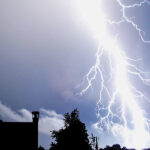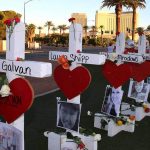Anyone who has ever worked an outdoor show seems to have a story to share about how the weather almost defeated them. My go-to tale happened at a casino just outside of Omaha, NE. It was one of those sticky, late-July days when humidity hung heavy in the air. Doors were set for 4 pm, but by 3:30, anxious audience members had already abandoned the comfortable temperature of the casino to gather at the entrance of the large general admissions field we called our office that day.
A Beautiful Day…
Behind the stage were rows of corn, with a few silos lining the horizon. All morning, my phone buzzed with the warning of area storms, but at the venue, it had been a beautiful day. Large white clouds added to the picturesque Midwestern landscape as we settled into the relaxed, pre-show lull that happens when crews have traveled together for some time. I worked on the next day’s schedule. Some snacked. Others fiddled with their gear backstage. A few were on the bus cheering for some kind of sporting event.
 Then, all at once, as if from nowhere, the sky grew dark. On the edge of a large field, we saw it approaching, and it was coming quickly. The fluffy clouds were overtaken by an ominous sheet of gray. We all stood for a moment, watching the angry advance. I looked at my phone. There was no warning or alert about afternoon showers, but it was obvious we were about to get hit. The thickness dropped out of the air as the wind swept through the parking lot being used as our backstage. We all rushed for our gear.
Then, all at once, as if from nowhere, the sky grew dark. On the edge of a large field, we saw it approaching, and it was coming quickly. The fluffy clouds were overtaken by an ominous sheet of gray. We all stood for a moment, watching the angry advance. I looked at my phone. There was no warning or alert about afternoon showers, but it was obvious we were about to get hit. The thickness dropped out of the air as the wind swept through the parking lot being used as our backstage. We all rushed for our gear.
The large grid had to be lowered. Road cases wrapped in tarps. The console, and other expensive equipment, rushed to cover. I had a few mirrors, makeup and costume changes set backstage right. As the stage roof dropped, my wardrobe pieces faced full exposure to the large raindrops that began to fall. I grabbed everything, trying to make it all in one trip, and ran for the building.
…Gets Scary Quickly
It had gotten scary out. Rain hit the ground in sheets and the trees bent every which way. Some die-hard fans tried to linger as security urged them inside. The sky was a deep mix of purple, blue, and slate. Lightning sliced across the sky and thunder rattled the windows of our bus. I was still only halfway to the building, drenched, along with the pile of wardrobe accessories I struggled with. A few had reached shelter, but most of us were still battling to save our work stations, or making the dash back.
Suddenly, the entire sky flashed to white—an engulfing, hot-white light that seemed to sit right on top of us. Before I could stop myself, I was crouched on the ground. The hair on my neck stood on end. The hairbrushes and blush compacts scattered everywhere. The air smelled burnt, almost electric. A loud roar rolled across the lot, bouncing off the building.

Had I been struck by lightning? No. No, I seemed okay, though my heart was racing. Had anyone been hit? Looking around, most of us were nose to
the asphalt, covering our heads. Slowly standing, we all looked around, checking our limbs, our gear, our friends. Everyone seemed okay. It had definitely been a bolt of lightning, and certainly been close. As it turns out, it had been drawn to the rod on top of the casino.
The storm raged on for another few minutes, then rolled out as quickly as it had arrived. Of course, looking back, it’s possible I remember it all with a bit of added drama and flair. After all, this is show business. However, I still remember the smell, the fear, and the absolutely unanticipated magnitude of that moment. I was overwhelmed for myself, for the crowds of people waiting, for our gear, for the venue. It was the closest I’d come to facing the sheer power and intensity of Mother Nature herself. We were lucky. In reality, anything could have happened.
Preparing, Not Reacting
“Weather is extremely unpredictable, but in the world of live events, the responsibility of protecting audiences, crew and gear falls to the production,” says Rich Barr, a veteran tour production manager and co-founder of Perfect Storm. “Keeping everyone safe has to be a priority. Unfortunately, with all the other aspects of putting on a show, it can get swept aside until it’s too late. It’s not enough to simply react to weather emergencies. It is time for our industry to start preparing in advance. It’s important to adopt strategic plans for these situation that will, inevitably, arise.”
Mike Chapman, meteorologist at the National Center for Atmospheric Research, has been a longtime friend of Barr’s, often visiting him on site at local shows. Familiar with the highest level of technical weather predication equipment, Chapman admits, “I am always surprised how these large productions seem to have almost no preparation for the elements. Everything else in these performances are so elaborate and intricate. However, without a plan, they can be completely shut down by a little rain, snow or wind at the wrong moments.”
“After years of leading productions around the globe, Barr has seen it all,” Chapman continues. “I use to quiz him on emergency procedures, the “what-if” scenarios, his forecast predications, etc. It seems most shows rely on phone apps or airport reports, but for such an extravagant industry, that just isn’t enough. The weather technology is there, but no one in live-entertainment seems to be utilizing it fully.”

Specific Events and Venues
That is, until now. Drawing upon Barr’s extensive touring knowledge and Chapman’s meteorological career, the two formed Perfect Storm in 2013. Unlike other generic weather services, such as local forecasts, airport reports, or phone apps, Perfect Storm’s mission is to offer a direct approach to the needs of each client, helping to educate, advise and implement weather safety procedures for any live-event.
Providing summarized details every 12 hours to productions, tours can customize what they are looking for in the service. If the need presents, Perfect Storm can even provide onsite personal. Instead of relying on weather predictions for an entire town or county, Chapman looks at how storms approach specific venue locations.
Making its first full launch debut during the summer of 2014 with Beyoncé and Jay Z’s “On the Run” Tour, Perfect Storm is already leaving its mark. Live Nation tour director Ron Chamberlain certainly noticed a difference, “This tour required separate days for steel build and tear down. With daily multi-city activities, the Perfect Storm update emails were a helpful and easy way to stay up to speed on every location throughout the tour. Plus, we’d get updates if anything changed throughout the day. Knowing what, if any, weather systems were in the area made our show days more efficient.”
However, Perfect Storm is more than a simple weather notification system. Along with a twice daily forecasts, the team works together to optimize productivity during the most challenging conditions. With mobile weather stations, this applies to both venue sites and transportation. Coordinating with drivers, for example, helps trucks and buses steer clear of large patches of danger including possible tornados, blizzards or hurricanes. Sometimes, detouring only a few miles around the heart of a storm can ensure a smoother, safer ride for all.
Crew Education
To further promote safety, and ultimately lower insurance costs, Perfect Storm also takes time to educate crews on emergency procedure. In a crunch, every moment counts. A well-informed staff increases accuracy and security. “Our crew had one-on-one training to learn the best way to deal with fierce weather fronts,” notes Chamberlain of the “On the Run” Tour. “During rehearsals in Miami, a short, high-wind and rain system came through. Our personalized emergency plan and their advanced warning system allowed enough time to evacuate the stage and stadium floor safely.”
Although storms will always be one of the most difficult safety risks to know about in advance of a show, every live outdoor event must be prepared. Perfect Storm was formed to fill that need within the industry, and during 2014, their first year, along Beyoncé and Jay Z’s “On the Run” Tour, the organization has had the opportunity to work with Drake, the Susan G. Komen Foundation and a few other one-offs. Most recently, they teamed up with One Direction on their “Where We Are” Tour. “In the USA, in particular, I am finding that weather has an increasingly bigger impact on decisions to run, suspend, or even cancel shows on a day-to-day basis,” notes “Where Are We” tour production manager Wob Roberts. For stadium tours such as his, he adds, it’s important that forecasts are not just accurate within, say, a 15-mile radius, but for the exact location of a given venue.
Those of us who have worked at these events know first-hand just how unpredictable Mother Nature can be. In recent years, the news has been littered with the horrific realities of what can happen when the elements win. Barr is adamant: “Perfect Storm is here to help keep all of us production professionals feel safer and more confident in our work environments. With the level of gear, the number of fans, and the variety of locations these live-events collect, it is essential to be prepared for the worst, not simply hope for the best. Perfect Storm is the best tool for productions in the face of bad weather.”
Company Snapshot
Company: Perfect Storm LLC
Founded By: Richard Barr, live event labor production manager/stage manager (iHeartRadio, 2010-2013; DPS, 2009-2013) and Michael Chapman, meteorologist at the National Center for Atmospheric
Research/NCAR.
When Founded: 2013
Where Based: Arvada, CO
Key Clients/Gigs: Beyoncé and Jay-Z’s “On the Run” tour (June 25-Sept. 13, 2014); One Direction’s “Where We Are” tour (April 25-Oct. 5, 2014)
More Info: (www.perfectstorm.tv)
Rachel Pfennig Hales is a production crew member and freelance writer based in Pennsylvania.

